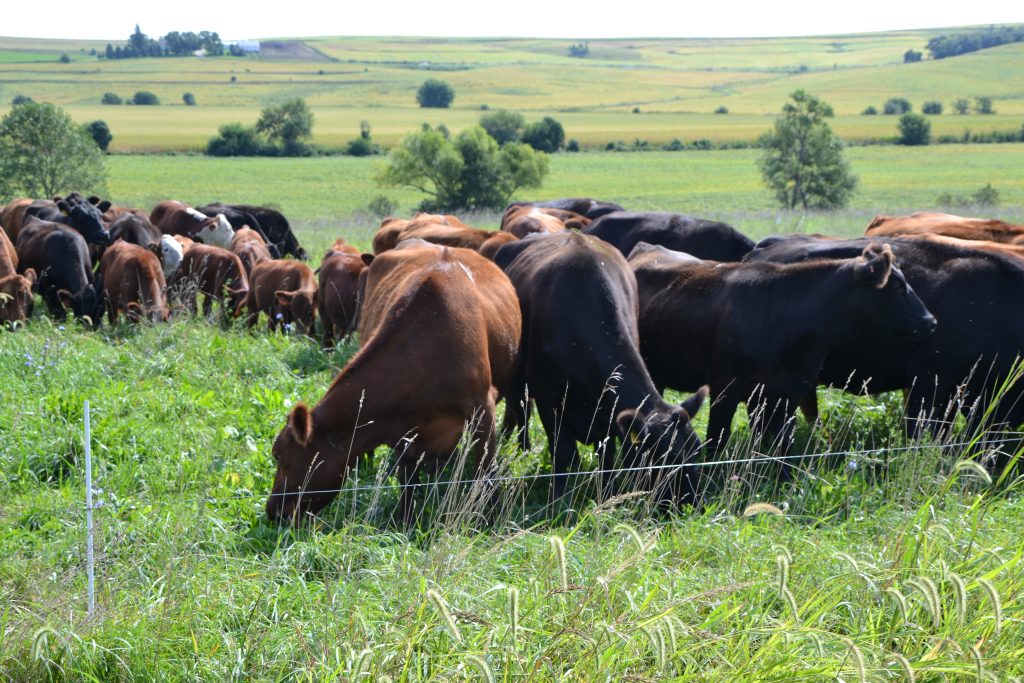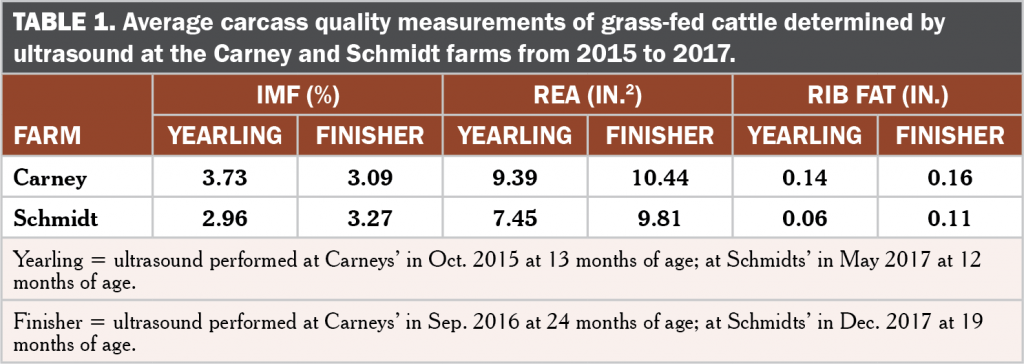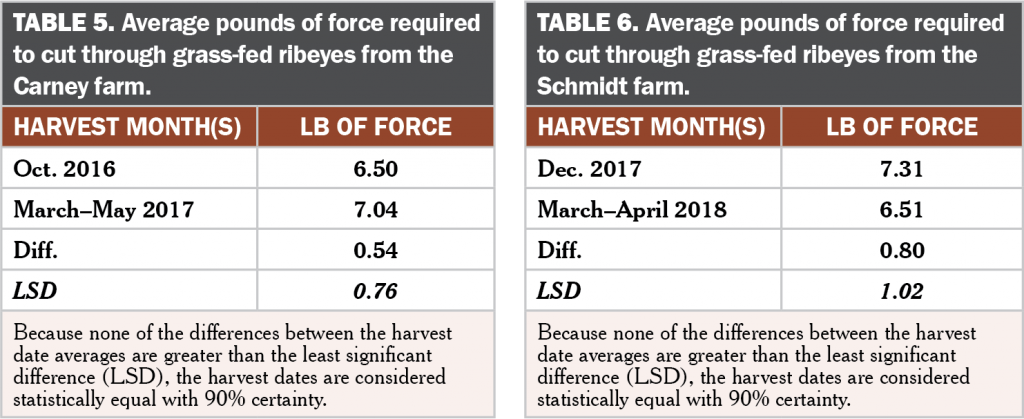Carcass Characteristics, Meat Quality and Fatty Acid Composition of 100% Grass-Fed Beef
Funding by Natural Resource Conservation Service (NRCS). This material is based upon work supported by the Natural Resources Conservation Service, U.S. Department of Agriculture, under number 69-6114-15-009.
In a Nutshell:
- Determining the optimal harvest window for 100% grass-fed cattle is a challenge.
- Farmer-cooperators used ultrasound to measure muscle characteristics in live grass-fed cattle prior to harvest.
- Laboratory analysis was conducted on 27 ribeyes from two farms to ascertain meat quality and fatty acid composition.
Key Findings
- Ultrasound was not a viable tool for predicting optimal harvest windows for these farmers.
- The average omega-6:3 ratio of grass-fed ribeyes was 1.77:1 from Carneys’ farm and 1.83:1 from Schmidts’ farm, which falls within the range of recommendations for healthy diets.
- Farmers worry winter feed may negatively impact meat quality since hay is generally lower in quality than fresh forage. Results showed harvesting cattle after winter did not negatively affect meat quality.
Background
Grass-fed beef requires a proper finish to ensure an enjoyable eating experience. Grass-finishing, when cattle consume only forage prior to harvest, is influenced by a variety of factors including genetics, feed resources and management. Because grass-finished cattle display different external attributes than grain-finished cattle, it is more difficult to identify when an animal is ready to harvest. Ultrasound technology is used to look at muscle confirmation in live animals. Ultrasound helps to identify how an animal’s muscles are developing and may help to inform farmers of when to harvest because it is difficult to tell by visual appraisal alone.
Proper grass-finishing also contributes to the tenderness and nutritional benefits of the meat. Advocates of 100% grass-fed beef claim that it contains a healthy balance of omega fatty acids. A healthy diet should consist of roughly one to four times more omega-6 than omega-3 fatty acids.[1] On average, the omega-6:3 ratio for grass-fed cattle is 2:1, while the ratio for grain-fed cattle is 9:1.[1] Human beings evolved on a diet with an omega-6:3 fatty acid ratio of approximately 1:1, whereas the ratio in today’s Western diets is around 20:1 or higher.[2] This indicates an excess of omega-6 fatty acids and a deficiency in omega-3 fatty acids. Increased consumption of omega-3 fatty acids is known to decrease the risks of inflammation and cardiovascular and autoimmune diseases; research has found that a ratio of 2.5:1 reduced cancer cell proliferation.[3] Cooperators conducted this study to determine how their 100% grass-fed beef contributes to an enjoyable and healthy eating experience.
Objective: 1) Evaluate the usefulness of ultrasound in determining the optimal harvest window of grass-fed cattle; and 2) Determine the fatty acid content, tenderness and eating experience of ribeye steaks from grass-fed cattle.
Methods
This study was conducted by Bruce and Connie Carney near Maxwell in Story County and Dave and Meg Schmidt near Exira in Audubon County. Both farms raise 100% grass-fed cattle. The Carneys raise Angus Cross cattle, and the cattle involved in this study were born in the fall of 2014. Schmidts raise Red and Black Angus cattle and their cattle were born in the spring of 2016.
Twelve cattle from the Carney farm and 11 cattle from the Schmidt farm were ultrasounded and weighed twice in their life, as yearlings at approximately 13 and 12 months of age and during the finishing phase at approximately 24 and 19 months of age, respectively. Ultrasound was conducted by Dr. Shawn Nicholson, DVM at Stuart Veterinary Clinic and determined percent intramuscular fat (IMF), ribeye area (REA) and backfat thickness (Rib Fat) of each individual animal. Cattle weights were recorded at the time of each ultrasound.
Cattle were harvested at the discretion of the farmers. The Carneys harvested cattle in October 2016 (at 25 months of age) and from March to May 2017 (at approximately 31 months of age); carcass weights averaged 649 lb, ranging from 588 to 772 lb. The Schmidts harvested cattle in December 2017 (at 20 months of age) and from March to April 2018 (at 22 months of age); carcass weights averaged 575 lb, ranging from 528 to 628 lb.
After harvest, 14 ribeyes from the Carneys’ cattle and 13 ribeyes from the Schmidts’ cattle were sent to laboratories at Iowa State University to be analyzed for fatty acid content, tenderness and sensory evaluation. Both farmers submitted two additional ribeye samples on top of the ribeyes from each animal that was ultrasounded.
Data were analyzed using JMP Pro 13 (SAS Institute Inc., Cary, NC) statistical software. Relationships among IMF, REA, Rib Fat and fatty acid contents between ultrasound dates were examined using correlation analyses. Means separations of omega-6 and -3 contents are reported using the least significant difference (LSD) generated by a t-test. Statistical significance was determined at the 90% confidence level.
Results and Discussion
Ultrasound
IMF, REA and Rib Fat measurements are reported in Table 1 and constitute carcass quality. Results showed that IMF and REA measurements taken when cattle were yearlings did not significantly correlate to measurements taken during the finishing phase at either farm. At Carneys’ the two Rib Fat measurements were not correlated, and at Schmidts’ they were negatively correlated. Therefore, it was not possible to use yearling ultrasound data to make predictions regarding finishing phase carcass quality. One implication for the use of ultrasound may be if meat is sold based on USDA Quality Grade. Both Carneys and Schmidts direct market their beef, which is not USDA graded. If it were, their beef would have graded choice or select.[4]
Cattle harvested prior to winter weighed significantly more than spring harvested cattle at the time of the second ultrasound. The Carneys and Schmidts made harvest decisions based on the liveweights of cattle determined on the respective second ultrasound dates (Sep. 2016 at Carneys’ and Dec. 2017 at Schmidts’). The Carneys chose to harvest 4 cattle with an average liveweight of 1,004 lb in Oct. 2016 and keep 8 cattle with an average liveweight of 895 lb to harvest between March and May 2017. The Schmidts chose to harvest 5 cattle with an average liveweight of 1,052 lb in Dec. 2017 and keep 6 cattle with an average liveweight of 933 lb to harvest between March and April 2018. For both the Carneys and Schmidts, harvest decisions were based on the weight of the animal at the second ultrasound, not IMF, REA or Rib Fat measurements. Cattle that weighed less were kept through the winter and harvested in spring. This trial showed that ultrasound was not a viable tool in predicting optimal harvest windows.
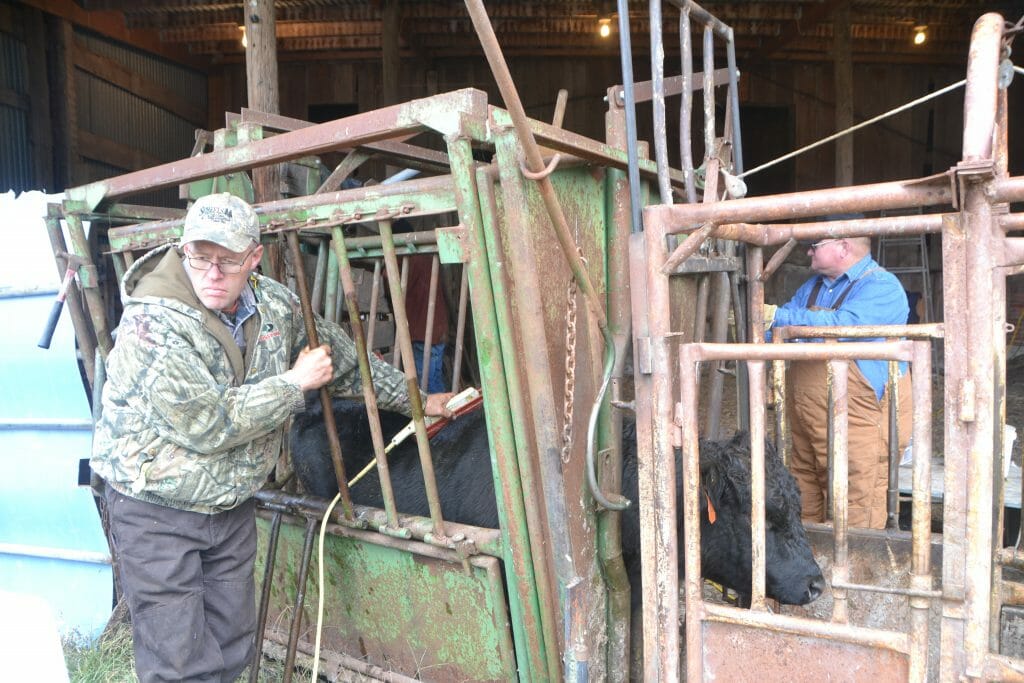
Veterinarian Shawn Nicholson ultrasounded cattle as yearlings and finishers to determine intramuscular fat, ribeye area and back fat thickness.
Fatty acid content
Average saturated fatty acids (SFA), monounsaturated fatty acids (MUFA), polyunsaturated fatty acids (PUFA), and conjugated linoleic acid (CLA) across both harvest dates at both farms are listed in Table 2. In Carneys’ beef, SFA comprised 44.95% of the total fatty acids, whereas MUFA and PUFA combined comprised 47.31%. In Schmidts’ beef, SFA comprised 41.90% of the total fatty acids, whereas MUFA and PUFA combined comprised 49.10% (Table 2). Saturated fat is considered a potentially harmful dietary fat, whereas monounsaturated and polyunsaturated fats are considered potentially helpful.[5]
 CLA is a type of omega-6 fatty acid. The average CLA content in Carneys’ ribeyes was 0.02 g/100g and Schmidts’ was 0.01 g/100g (Table 2); contributing the least amount of total fatty acids. Research shows that consuming 1 to 3.5 g/d of CLA provides health benefits[1] and that CLA content is higher in grass-fed animals products than in grain-fed animal products.[6]
CLA is a type of omega-6 fatty acid. The average CLA content in Carneys’ ribeyes was 0.02 g/100g and Schmidts’ was 0.01 g/100g (Table 2); contributing the least amount of total fatty acids. Research shows that consuming 1 to 3.5 g/d of CLA provides health benefits[1] and that CLA content is higher in grass-fed animals products than in grain-fed animal products.[6]
Omega-6 and omega-3 fatty acid content by harvest season
Omega fatty acids are a type of polyunsaturated fat. The average omega-6:3 ratio in Carneys’ ribeyes was 1.77:1 and Schmidts’ was 1.83:1. Omega-6 and -3 fatty acid concentrations in ribeyes from cattle harvested at different times of the year at both farms is shown in Tables 3 and 4.
The results showed that harvesting cattle in the spring, after feeding them through the winter on hay and baleage, did not negatively affect the omega ratio. Tables 3 and 4 show at both farms, the omega ratio for beef harvested prior to winter (Oct. and Dec.) was, in fact, higher than spring harvested beef (March through May). The Carneys’ spring harvested cattle had a significantly lower (better) omega ratio (1.64:1) than the fall harvested cattle (2.03:1) (Table 3). The Schmidts’ spring harvested cattle also had a significantly lower omega ratio (1.80:1) compared to their winter harvested cattle (1.86:1)(Table 4).
 Regardless of harvest date, the omega ratios of the beef harvested at both farms contained an omega fatty acid balance that falls within the range of recommendations for healthy diets.[1] Dave Schmidt said, “If you’re looking to adjust your diet to bring down these ratios, grass-fed beef is one way to do it.”
Regardless of harvest date, the omega ratios of the beef harvested at both farms contained an omega fatty acid balance that falls within the range of recommendations for healthy diets.[1] Dave Schmidt said, “If you’re looking to adjust your diet to bring down these ratios, grass-fed beef is one way to do it.”
 Ribeye tenderness by harvest season
Ribeye tenderness by harvest season
The ribeyes were subjected to the Warner-Bratzler Shear Force test, which measures the force required to cut through a cooked piece of meat. Tables 5 and 6 show no significant difference in ribeye tenderness between harvest season; the Carneys’ ribeyes averaged 6.77 lb of force and the Schmidts’ averaged 6.97 lb of force. Across both farms, the average force required to cut the 27 ribeyes was 6.87 lb, ranging from 5.5 to 8.1 lb, which is considered very tender to tender.[7] In addition, tenderness was not significantly correlated to IMF scores (Table 1) determined by ultrasound.
Sensory evaluation
Ribeye samples were taste-tested by a group of panelists in Iowa State University’s Food Science and Human Nutrition department. Average scores across both harvest dates at both farms are reported in Table 7 and based on a 1-10 scale. According to Dr. Ken Prusa, a professor in the department, a typical USDA choice grade ribeye should have a tenderness score of ≥8 eight and chewiness score of ≤3.
The Warner-Bratzler shear force test ranked the ribeyes as tender (Tables 5 and 6), whereas the sensory evaluation ranked them a 5.2 on a 1-10 scale (Table 7). The difference in these results from the two different testing methods could have come down to a difference in cooking. In both cases, the samples were prepared according to each lab’s protocol, which required the ribeyes to be cooked until 154oF (approximately medium well) on a clam-shell style grill preheated to 400oF. High temperatures and an expedited method of cooking may have affected the eating experience.
It is well known that preparation plays a significant role in the eating experience of grass-fed beef – low and slow is key.[8] Grass-fed beef is generally leaner than grain-fed beef, meaning there is less insulation in the meat, and therefore moisture and fat will be lost if it is cooked too hot.[9] “Grass-fed beef, when cooked properly, is capable of comparing more favorably in juiciness and tenderness to grain-fed beef than is indicated by the ISU results,” commented Dave Schmidt.
Flavor
The sensory evaluation shows the ribeyes had a beef flavor that ranked 3.4, with the detection of other flavors, ranking 4.2 (Table 7). The results described some of these other flavors as gamey, metallic, grassy and oxidized. Dr. Prusa believes these flavors are normal in grass-fed beef. “We help our customers realize our beef may taste more like deer or elk, which eat what’s available to them at different times of the year. This results in different meat flavors with varying consistency, more like wild animals,” said Bruce Carney.
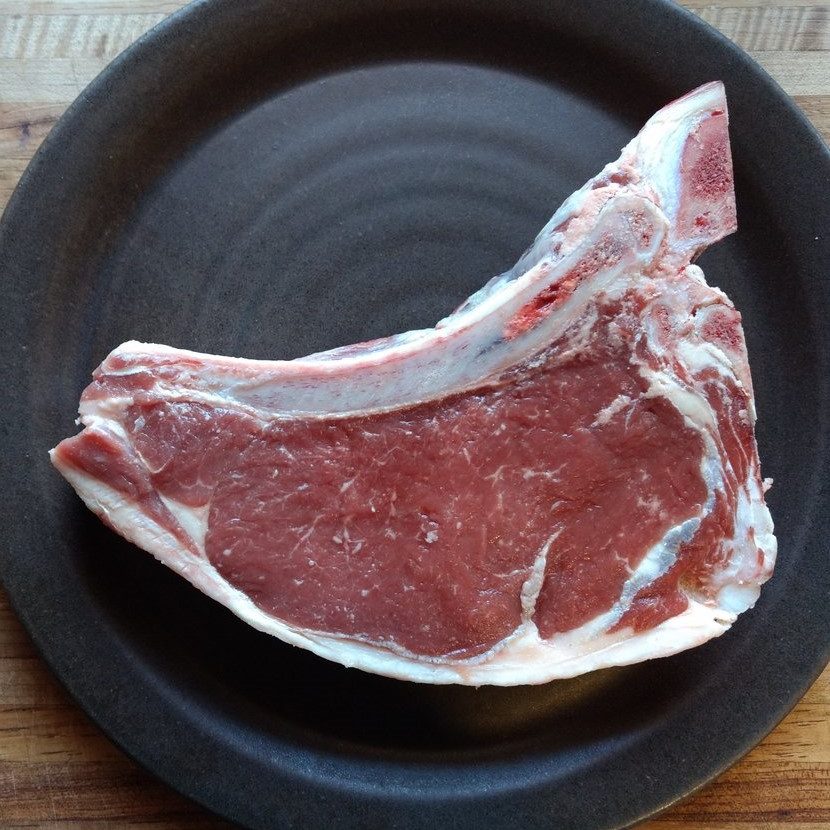
One of the grass fed ribeyes submitted to Iowa State University for meat quality and fatty acid analysis.
In addition, “Off-flavors have to do with environmental conditions. In a drought, forage quality decreases. Consistency is harder to achieve in grass-fed versus grain-fed because feeding grain provides control. We’re at the mercy of mother nature,” added Bruce Carney, “As we build soil health on our farms and learn how to grow better quality and higher Brix forages, these flavors will improve.”
Conclusions and Next Steps
In this trial, the Carneys and Schmidts evaluated 100% grass-fed cattle carcasses and ribeyes. Both determined ultrasound is not a viable tool for predicting optimal harvest window in grass-fed cattle but found it useful during yearling phase in determining which cattle should be kept for grass-finishing and which to sell before finishing stage. In both cases, harvest decisions were made based on the weight of cattle, not ultrasound scores, therefore a weigh scale was the better decision-making tool.
Harvesting cattle in the spring, after feeding them over winter, did not negatively affect the omega fatty acid ratio or tenderness of beef (Tables 3-6). In fact, spring harvested cattle yielded better (lower) omega ratios at both farms and season of harvest made no significant difference in tenderness. These results confirm the omega fatty acid content of both farms’ beef exceeds the recommendation for healthy diets.
“We work hard to keep our cattle gaining weight on an all-forage diet. Having ISU confirm that our beef really does have the beneficial characteristics of a grass-fed ration is very gratifying,” said Dave Schmidt. Bruce Carney added, “Grass-fed producers are able to use the reported health benefits to differentiate ourselves and we need to continue talking about the health aspect of our product.”
References
- Daley, C.A., A. Abbott, P.S. Doyle, G.A. Nader and S. Larson. 2010. A review of fatty acid profiles and antioxidant content in grass-fed and grain-fed beef. Nutrition journal. 9:10. http://www.ncbi.nlm.nih.gov/pubmed/20219103 (accessed April 2019).
- Simopoulos, A.P. 2016. An Increase in the Omega-6/Omega-3 Fatty Acid Ratio Increases the Risk for Obesity. Nutrients. 8:128. http://www.ncbi.nlm.nih.gov/pubmed/26950145 (accessed April 2019).
- Simopoulos, A.P. 2008. The Importance of the Omega-6/Omega-3 Fatty Acid Ratio in Cardiovascular Disease and Other Chronic Diseases. Experimental Biology and Medicine. 233:674–688. http://www.ncbi.nlm.nih.gov/pubmed/18408140 (accessed April 2019).
- What’s Your Beef – Prime, Choice or Select? | USDA. https://www.usda.gov/media/blog/2013/01/28/whats-your-beef-prime-choice-or-select?page=1 (accessed April 2019).
- Macronutrients, P. on., S. on U.R.L. of N. and I. and U. of D.R. Intakes and S.C. on the S.E. of D.R. Intakes. 2004. Dietary Reference Intakes for Energy, Carbohydrate, Fiber, Fat, Fatty Acids, Cholesterol, Protein, and Amino Acids (Macronutrients). National Academies Press. https://www.mayoclinic.org/healthy-lifestyle/nutrition-and-healthy-eating/in-depth/fat/art-20045550 (accessed May 2019).
- Dhiman, T.R., G.R. Anand, L.D. Satter and M.W. Pariza. 1999. Conjugated Linoleic Acid Content of Milk from Cows Fed Different Diets. Journal of Dairy Science. 82:2146–2156. http://www.ncbi.nlm.nih.gov/pubmed/10531600 (accessed April 2019).
- Rey, J., W. Savell, J.C. Brooks, C. Carr, K.B. Gehring, D. Griffi, D. Hale, G. Mafi, D.D. Johnson, C. Lorenzen, R. Maddock, R. Miller, D. Vanoverbeke, H.A. Henderson, A.N. Arnold and B.E. Wasser. 2016. 2015/2016 National Beef Tenderness Survey. https://www.beefresearch.org/CMDocs/BeefResearch/PE_Executive_Summaries/2016_NBTS_ExecSummaryLR112216-08.pdf (accessed April 2019).
- American Grassfed Association. 2011. Tips for Cooking Grassfed Beef. https://www.americangrassfed.org/wp-content/uploads/2011/11/Tips-for-Cooking-Grassfed-Beef.pdf (accessed May 2019).
- Hayes, S. 2004. The grassfed gourmet cookbook : healthy cooking and good living with pasture-raised foods. Eating Fresh. https://books.google.com/books?id=2NctAAAACAAJ&dq=gourmet+grass+fed+cookbook&hl=en&sa=X&ved=0ahUKEwjf28Lr4dzhAhVQJKwKHXiBAyUQ6AEIKzAA (accessed April 2019).


